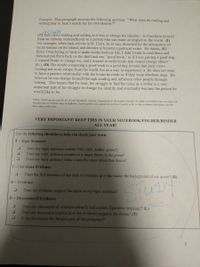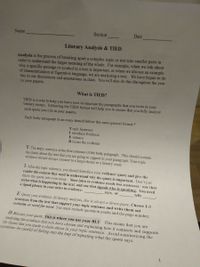Question
thumb_up100%
What roles do reading and writing play in Maya Angelou's search for her own identity?

Transcribed Image Text:Example: This paragraph answers the following question: "What roles do reading and
writing play in Jack's search for his own identity?"
Eclaim
(T) Jack views reading and writing as a way to change his identity-to transform himself
from an unlucky underachiever to a person who can make an impact on the world. (I)
For example, when Jack arrives in St. Croix, he is very disturbed by the atmosphere of
racial tension on the island, and decides to become a political writer. He thinks, (E) "
Since I was trying so hard to make books lead my life, I didn't want to read them and
then just put them back on the shelf and say, “good book," as if I was patting a good dog.
I wanted books to change me, and I wanted to write books that would change others"
(61). (D) The simile comparing a good book to a good dog reveals that Jack views
reading not as an escape from the world, but as a way to experience it. He does not want
to have a passive relationship with the books he reads as if they were obedient dogs. He
believes he can change himself through reading and influence other people through
writing. This means that for Jack, his struggle to find his voice as a writer is a very
important part of his struggle to change his identity and eventually become the person he
would like to be.
*Note: TIED can
introduction to evidence may be different. Each teacher will explain to you how it works in his or her academic discipline, but the
basic ideu is the same.
used for all of yvour academic subjects. Depending on the subject, though, the kinds of evidence you use and your
VERY IMPORTANT! KEEP THIS IN YOUR NOTEBOOK/FOLDER/BINDER
ALL YEAR!
Use the following checklist to help you check your work:
T-Topic Sentence
Does my topic sentence contain TAG (title, author, genre?)
Does my topic sentence connect to a larger theme in the poem?
Does my topic sentence make a specific claim about that theme?
I-Iatroduce Evidence
Does the first sentence of my intro to evidence give the reader the background of my quote? (B)
E Evidence
STUDY
Does my evidence support the claim in my topic sentence?
D Discussion of Evidence
Does my discussion of evidence identify and explain figurative language? (L)
Does my discussion explain how the evidence supports the theme? (T)
Is my discussion the longest part of the paragraph?

Transcribed Image Text:Section
Date
Name
Literary Analysis & TIED
Analysis is the process of breaking apart a complex topic or text into smaller parts in
order to understand the larger meaning of the whole. For example, when we talk about
why a specific passage or symbol in a text is important, or when we discuss an example
of characterization or figurative language, we are analyzing a text. We have begun to do
this in our discussions and annotations in class. You will also do this throughout the year
in your papers.
What is TIED?
TIED is a way to help you learn how to structure the paragraphs that you write in your
literary essays. Following the TIED format will help you to ensure that you fully analyze
each quote you cite in your papers.
Each body paragraph in an essay should follow this same general format:*
T opic Sentence
I ntroduce Evidence
E vidence
D iscuss the evidence
T: The topic sentence is the first sentence of the body paragraph. This should contain
the claim about the text that you are going to support in your paragraph. Your topic
sentence should always connect to a larger theme in a literary essay.
1: After the topic sentence, you should introduce your evidence/ quote and give the
reader the context they need to understand why the quote is important.. Don't just
throw the quote into your essay. Your intro to evidence needs two sentences: one that
states what is happening in the text, and one that signals who is speaking. You need
a signal phrase in your intro to evidence:
says, or
tells
E: Quote your evidence. In literary analysis, this is always a direct quote. Choose 1-3
sentences from the text that support your topic sentence and write them out
verbatim, or word for word. You must include quotation marks and the page number.
D: Discuss your quote. This is where you use your BLT. This means that you are
analyzing the evidence that you have chosen and explaining how it connects and supports
the theme that you made a claim about in your topic sentence. Avoid summarizing the
quotation--be careful of falling into the trap of repeating what the quote says.
1
Expert Solution
This question has been solved!
Explore an expertly crafted, step-by-step solution for a thorough understanding of key concepts.
This is a popular solution
Trending nowThis is a popular solution!
Step by stepSolved in 3 steps
